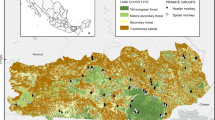Abstract
Intensive strip census methods were used to estimate population density and age-sex composition of a natural population of the spider monkeyAteles geoffroyi, in seasonally dry forest at Tikal, Guatemala. An objective procedure for determining effective strip width is discussed, and various census methods, including direct count and strip census, are evaluated as to merits and disadvantages
Similar content being viewed by others
References
Carpenter, C. R., 1935. Behavior of red spider monkeys in Panama.J. Mammal., 16: 171–180.
Coelho, A. M., Jr., C. A. Bramblett, L. B. Quick, &S. Bramblett, 1976. Resource availability and population density in primates: a sociobioenergetic analysis of energy budgets of Guatemalan howler and spider monkeys.Primates, 17: 63–80.
DeVore, I. &K. R. Hall, 1965. Baboon ecology. In:Primate Behavior,I. DeVore (ed.), Holt, Rinehart, & Winston, New York, pp. 20–52.
Durham, N. M., 1971. Effect of altitude difference on group organization of wild black spider monkeys (Ateles paniscus).Proc. 3rd Int. Congr. Primatol., 3: 32–40.
————, 1975. Some ecological, distributional, and group behavior features of Atelinae in southern Peru, with comments on interspecific relations. In:Socioecology and Psychology of Primates,R. Tuttle (ed.), Mouton, The Hague, pp. 87–101.
Eisenberg. J. F., 1976. Communication mechanisms and social integration in the black spider monkey,Ateles fusciceps robustus and related species.Smithsonian Contr. Zool, 113.
————, 1966. The behavior ofAteles geoffroyi and related species.Smithsonian Misc. Coll., 151: 1–63.
————, 1973. A preliminary analysis of a neotropical mammal fauna.Biotropica, 5: 150–161.
Emlen, J. T., 1971. Population densities of birds derived from transect counts.The Auk, 88: 323–342.
Hershkovitz, P., 1972. The recent mammals of the neotropical region: a zoogeographic and ecological review. In:Evolution, Mammals and Southern Continents,A. Keast et al. (eds.), State University of New York Press, Albany, pp. 311–432.
Klein, L. L., 1971. Observations on copulation and seasonal reproduction of two species of spider monkeys,Ateles belzebuth andA. geoffroyi.Folia primat., 15: 233–248.
————, 1972. The ecology and social organization of the spider monkey,Ateles belzebuth. Ph.D. dissertation, University of California, Berkeley.
————, 1974. Agonistic behavior in neotropical primates. In:Primate Aggression, Territoriality, and Xenophobia,R. L. Holloway (ed.), Academic Press, New York, pp. 77–122.
————, 1975. Social and ecological contrasts between four taxa of neotropical primates. In:Socioecology and Psychology of Primates,R. Tuttle (ed.), Mouton, The Hague, pp. 59–85.
----Klein, L. L. & ----D. J. Klein, 1976. Neotropical primates: aspects of habitat usage, population density, and regional distribution in La Macarena, Colombia. In:Neotropical Primates: Field Studies and Conservation,R. W. Thorington &P. Heltne (eds.), National Academy of Sciences, Washington, pp. 70–78.
Murie, A., 1935. Mammals from Guatemala and British Honduras.Univ. Mich. Mus. Zool. Misc. Publ., 26: 1–30.
Neville, M. K., 1976. The population and conservation of howler monkeys in Venezuela and Trinidad. In:Neotropical Primates: Field Studies and Conservation,R. W. Thorington &P. Heltne (eds.), National Academy of Sciences, Washington, pp. 101–109.
————, 1976. Censusing primate populations in the reserved area of the Pacaya and Samiria Rivers, Department Loreto, Peru.Primates, 17: 151–181.
Puleston, D. E., 1973. Ancient Maya settlement patterns and environment at Tikal: implications for subsistence models. Ph.D. dissertation, University of Pennsylvania, Philadelphia.
Robinette, W. L., C. M. Loveless, &D. A. Jones, 1974. Field tests of strip census methods.J. Wildl. Manage., 38: 81–96.
Schultz, A. H., 1956. Post-embryonic age changes. In:Primatologia I,H. Hofer et al. (eds.), Karger, Basel, pp. 886–964.
————, 1960. Age changes and variability in the skulls and teeth of the Central American monkeysAlouatta, Cebus, andAteles.Proc. zool. Soc. Lond., 133: 337–390.
Smithe, F. B., 1966.The Birds of Tikal. Natural History Press, Garden City, New York.
Struhsaker, T. T., 1975.The Red Colobus Monkey. University of Chicago Press, Chicago.
Thorington, R. W., Jr., 1972. Censusing wild populations of South American monkeys. In:International Movement of Animals, Pan American Health Organization, WHO Sci. Publ., 23: 26–32.
Wagner, H. O., 1956. Freilandbeobachtungen an Klammeraffen.Z. Tierpsychol., 13: 302–313.
Wilson, C. C. &W. L. Wilson, 1975. Methods for censusing forest-dwelling primates. In:Contemporary Primatology,S. Kondo et al. (eds.), Karger, Basel, pp. 345–350.
Author information
Authors and Affiliations
About this article
Cite this article
Cant, J.G.H. Population survey of the spider monkeyAteles geoffroyi at Tikal, Guatemala. Primates 19, 525–535 (1978). https://doi.org/10.1007/BF02373314
Received:
Accepted:
Issue Date:
DOI: https://doi.org/10.1007/BF02373314




